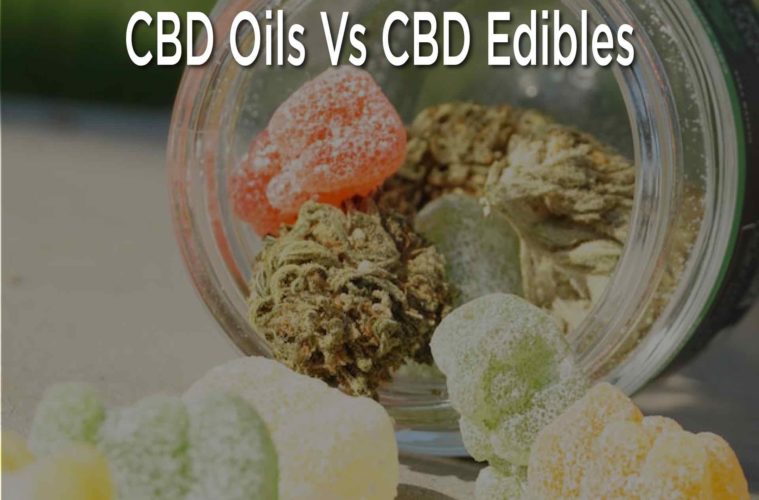View the original article about CBD Oils And Edibles at Trust CBD Oils.
When asked to pick one among the multitude of CBD products that are hitting the markets, each one will have a personal choice liked due to specific features of the product. CBD oils and CBD edibles are two CBD options that are quite popular among the CBD users.
In this session, we are making a comparison of CBD oil and CBD edibles.
Intake Method
The most common administering method of CBD oils is sublingual intake but that doesn’t imply that it is the exclusive method of taking CBD oil. CBD oils can be added to edibles and beverages making the edible or beverage similar to any common ingestible CBD product.
In a sublingual method, CBD oil is measured out in a dropper to ensure that the serving is in the right dosage and kept under the tongue for 60 seconds before swallowing it. During the time when the CBD oil is kept under the tongue, CBD in the oil enters the bloodstream directly through the sublingual gland. As the name suggests, CBD edibles are similar to that of any normal edible and the intake method is no different.
Preparation
CBD is a fat soluble compound and CBD oils are made by dissolving CBD extract into carrier oils. The CBD is extracted using extraction methods like CO2 extraction, ethanol extraction etc. CBD edibles are prepared by adding CBD extract to traditional edibles like gummies, candies, chocolate etc.
Potency
Potency refers to the amount of CBD contained in each serving of the CBD product indicating that lower the number of additional ingredients, higher the potency of the product. CBD oils contain a minimal number of ingredients. In fact most of the CBD oils do not even contain taste enhancing ingredients that are commonly added in other products like CBD tinctures. The minimal ingredient profile explains why CBD oils have an earthy flavor.
CBD edibles come with a lot of ingredients apart from the CBD extract added to it and all of these additional ingredients could lead to reduced potency of CBD edibles. CBD oils have higher potency than that of CBD edibles.
Bioavailability
Bioavailability is a characteristic feature of the intake method of a CBD product. It refers to the amount of CBD that reaches our bloodstream when we use a CBD product. When CBD oils are consumed sublingually, the CBD reaches the bloodstream directly and have to undergo processing by the digestive system.
CBD edibles has to be digested in the stomach first prior to its absorption into the bloodstream indicating that the CBD in the edibles has to bypass the liver. The process reduces the amount of CBD that gets absorbed into the bloodstream. Hence sublingual CBD oils have an upper hand over CBD edibles in terms of bioavailability.
Time Taken For The Effects
As sublingual intake of CBD oils doesn’t require the processing of CBD by the digestive system, the effects are felt faster than the case of CBD edibles. The effects produced by CBD edibles depend on the time taken for the digestion of the edibles.
The digestive system and circulatory system work at different pace explaining why the food we eat lasts about 2 to three hours. The CBD edibles have to be digested prior to the absorption of CBD into the bloodstream indicating that it will take about an hour before you start to feel the effects of CBD.
Sublingual intake of CBD produces the effects faster than CBD edibles.
Duration of the effects
The time duration for which the effects of CBD last in our body depends on the type of CBD product that you take. When you take CBD edibles, they have to be digested in the stomach prior to the release of CBD into the bloodstream. The digestive system releases the CBD slowly after the edible is digested, which is why the effect of CBD lasts about 4 to 6 hours in our body providing long lasting relief.
Although sublingual CBD oil offers faster effects when compared to CBD edibles, the effects don’t longer like that of CBD edibles.
Spectrum Options
CBD is available in three spectrum options, full spectrum, broad spectrum and CBD isolate that differ in terms of the constituent compounds. Full spectrum CBD contains all the beneficial compounds in hemp plants including CBD, THC (less than 0.3%), other cannabinoids and terpenes. Broad spectrum CBD differs from full spectrum option only in terms of its THC content. It contains zero THC, all the while having all other plant compounds in full spectrum CBD. Isolate CBD has CBD as its exclusive content.
Spectrum options Full spectrum, broad spectrum and CBD isolate Full spectrum, broad spectrum and CBD isolate
While picking a CBD product from the store, make sure your selection is based on a thorough analysis of your medical condition as well the properties of the product.
Learn more about CBD Products at Trust CBD Oils.
Advertising disclosure: We may receive compensation for some of the links in our stories. Thank you for supporting Irvine Weekly and our advertisers.


